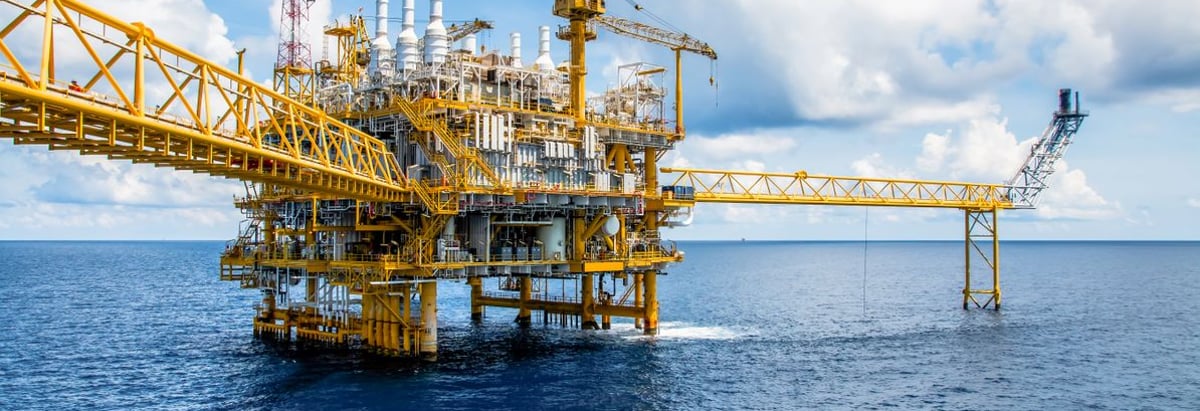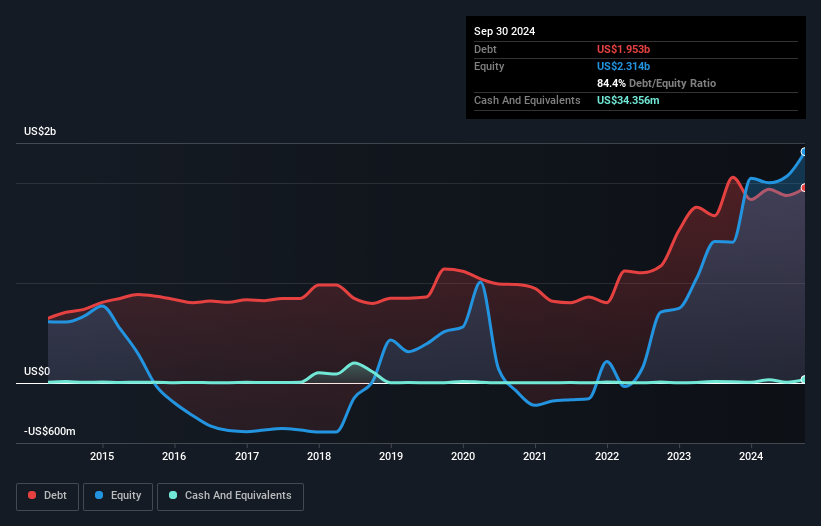- United States
- /
- Oil and Gas
- /
- NYSE:NOG
Here's Why Northern Oil and Gas (NYSE:NOG) Has A Meaningful Debt Burden

Howard Marks put it nicely when he said that, rather than worrying about share price volatility, 'The possibility of permanent loss is the risk I worry about... and every practical investor I know worries about.' When we think about how risky a company is, we always like to look at its use of debt, since debt overload can lead to ruin. We can see that Northern Oil and Gas, Inc. (NYSE:NOG) does use debt in its business. But is this debt a concern to shareholders?
What Risk Does Debt Bring?
Debt and other liabilities become risky for a business when it cannot easily fulfill those obligations, either with free cash flow or by raising capital at an attractive price. If things get really bad, the lenders can take control of the business. However, a more common (but still painful) scenario is that it has to raise new equity capital at a low price, thus permanently diluting shareholders. Of course, plenty of companies use debt to fund growth, without any negative consequences. The first step when considering a company's debt levels is to consider its cash and debt together.
See our latest analysis for Northern Oil and Gas
What Is Northern Oil and Gas's Debt?
The image below, which you can click on for greater detail, shows that Northern Oil and Gas had debt of US$1.95b at the end of September 2024, a reduction from US$2.06b over a year. And it doesn't have much cash, so its net debt is about the same.

How Strong Is Northern Oil and Gas' Balance Sheet?
Zooming in on the latest balance sheet data, we can see that Northern Oil and Gas had liabilities of US$420.3m due within 12 months and liabilities of US$2.32b due beyond that. Offsetting this, it had US$34.4m in cash and US$353.5m in receivables that were due within 12 months. So it has liabilities totalling US$2.35b more than its cash and near-term receivables, combined.
This deficit is considerable relative to its market capitalization of US$3.49b, so it does suggest shareholders should keep an eye on Northern Oil and Gas' use of debt. This suggests shareholders would be heavily diluted if the company needed to shore up its balance sheet in a hurry.
We use two main ratios to inform us about debt levels relative to earnings. The first is net debt divided by earnings before interest, tax, depreciation, and amortization (EBITDA), while the second is how many times its earnings before interest and tax (EBIT) covers its interest expense (or its interest cover, for short). Thus we consider debt relative to earnings both with and without depreciation and amortization expenses.
With net debt sitting at just 1.0 times EBITDA, Northern Oil and Gas is arguably pretty conservatively geared. And this view is supported by the solid interest coverage, with EBIT coming in at 8.0 times the interest expense over the last year. In addition to that, we're happy to report that Northern Oil and Gas has boosted its EBIT by 44%, thus reducing the spectre of future debt repayments. The balance sheet is clearly the area to focus on when you are analysing debt. But ultimately the future profitability of the business will decide if Northern Oil and Gas can strengthen its balance sheet over time. So if you're focused on the future you can check out this free report showing analyst profit forecasts.
Finally, while the tax-man may adore accounting profits, lenders only accept cold hard cash. So the logical step is to look at the proportion of that EBIT that is matched by actual free cash flow. During the last three years, Northern Oil and Gas burned a lot of cash. While investors are no doubt expecting a reversal of that situation in due course, it clearly does mean its use of debt is more risky.
Our View
Neither Northern Oil and Gas's ability to convert EBIT to free cash flow nor its level of total liabilities gave us confidence in its ability to take on more debt. But the good news is it seems to be able to grow its EBIT with ease. Looking at all the angles mentioned above, it does seem to us that Northern Oil and Gas is a somewhat risky investment as a result of its debt. Not all risk is bad, as it can boost share price returns if it pays off, but this debt risk is worth keeping in mind. There's no doubt that we learn most about debt from the balance sheet. However, not all investment risk resides within the balance sheet - far from it. For example, we've discovered 3 warning signs for Northern Oil and Gas (1 is significant!) that you should be aware of before investing here.
When all is said and done, sometimes its easier to focus on companies that don't even need debt. Readers can access a list of growth stocks with zero net debt 100% free, right now.
Valuation is complex, but we're here to simplify it.
Discover if Northern Oil and Gas might be undervalued or overvalued with our detailed analysis, featuring fair value estimates, potential risks, dividends, insider trades, and its financial condition.
Access Free AnalysisHave feedback on this article? Concerned about the content? Get in touch with us directly. Alternatively, email editorial-team (at) simplywallst.com.
This article by Simply Wall St is general in nature. We provide commentary based on historical data and analyst forecasts only using an unbiased methodology and our articles are not intended to be financial advice. It does not constitute a recommendation to buy or sell any stock, and does not take account of your objectives, or your financial situation. We aim to bring you long-term focused analysis driven by fundamental data. Note that our analysis may not factor in the latest price-sensitive company announcements or qualitative material. Simply Wall St has no position in any stocks mentioned.
About NYSE:NOG
Northern Oil and Gas
An independent energy company, engages in the acquisition, exploration, exploitation, development, and production of crude oil and natural gas properties in the United States.
Undervalued with solid track record.
Similar Companies
Market Insights
Community Narratives




